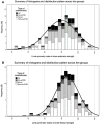General, spinal or regional anaesthesia does not affect strength performance 6 months after ACL reconstruction
- PMID: 35908113
- PMCID: PMC9898431
- DOI: 10.1007/s00167-022-07052-w
General, spinal or regional anaesthesia does not affect strength performance 6 months after ACL reconstruction
Abstract
Purpose: The recovery of strength is a key element in successfully returning to sports after ACL reconstruction. The type of anaesthesia has been suspected an influential factor in the post-operative recovery of muscle function.
Methods: In this retrospective analysis, n = 442 consecutive patients undergoing primary isolated ACL reconstruction using a hamstring autograft were analysed by pre- and post-operative isokinetic tests in a single orthopaedic centre. These were subdivided into four cohorts: (1) general anaesthesia (n = 47), (2) general anaesthesia with prolonged (48 h) on-demand femoral nerve block (n = 37), (3) spinal anaesthesia (n = 169) and (4) spinal anaesthesia with prolonged (48 h) on-demand femoral nerve block (n = 185). Primary outcome was the change from pre- to post-operative isokinetic strength during knee extension and flexion.
Results: Using one-way ANOVA, there was no significant influence of the type of anaesthesia. The main effect of anaesthesia on change in extension forces was not significant, and effect sizes were very small (n.s.). Similarly, the main effect of anaesthesia on change in flexion forces was statistically not significant (n.s.).
Conclusions: The findings of this study support the interpretation that the type of anaesthesia has no significant effect on the ability to recover thigh muscle strength 6 months after isolated hamstring ACL reconstruction. With regard to the recovery of athletic performance and return-to-sports testing criteria, there is no reason to avoid regional anaesthesia.
Level of evidence: III.
Keywords: ACL reconstruction; Isokinetic strength; Perioperative anaesthesia; Return-to-sports.
© 2022. The Author(s).
Conflict of interest statement
The authors declare that they have no conflict of interest.
Figures


Similar articles
-
Early ACL reconstruction shows an improved recovery of isokinetic thigh muscle strength compared to delayed or chronic cases.Arch Orthop Trauma Surg. 2023 Sep;143(9):5741-5750. doi: 10.1007/s00402-023-04863-5. Epub 2023 Apr 13. Arch Orthop Trauma Surg. 2023. PMID: 37052664 Free PMC article.
-
Femoral nerve block is associated with persistent strength deficits at 6 months after anterior cruciate ligament reconstruction in pediatric and adolescent patients.Am J Sports Med. 2015 Feb;43(2):331-6. doi: 10.1177/0363546514559823. Epub 2014 Dec 2. Am J Sports Med. 2015. PMID: 25466410
-
Higher hamstring-to-quadriceps isokinetic strength ratio during the first post-operative months in patients with quadriceps tendon compared to hamstring tendon graft following ACL reconstruction.Knee Surg Sports Traumatol Arthrosc. 2018 Feb;26(2):418-425. doi: 10.1007/s00167-017-4522-x. Epub 2017 Mar 21. Knee Surg Sports Traumatol Arthrosc. 2018. PMID: 28324151
-
Effects of Whole-Body Vibration Training on Knee Muscle Strength After Anterior Cruciate Ligament Reconstruction: A Critically Appraised Topic.J Sport Rehabil. 2022 Mar 1;31(3):356-361. doi: 10.1123/jsr.2021-0210. Epub 2021 Oct 25. J Sport Rehabil. 2022. PMID: 34697253 Review.
-
Quadriceps tendon autograft ACL reconstruction has less pivot shift laxity and lower failure rates than hamstring tendon autografts.Knee Surg Sports Traumatol Arthrosc. 2020 Feb;28(2):509-518. doi: 10.1007/s00167-019-05720-y. Epub 2019 Sep 19. Knee Surg Sports Traumatol Arthrosc. 2020. PMID: 31538227 Review.
Cited by
-
Predicting the Recovery of Isokinetic Knee Strength 6 Months After Anterior Cruciate Ligament Reconstruction.Orthop J Sports Med. 2024 Sep 4;12(9):23259671241264845. doi: 10.1177/23259671241264845. eCollection 2024 Sep. Orthop J Sports Med. 2024. PMID: 39247527 Free PMC article.
-
Anesthetic Considerations in Athletes: A Review.Cureus. 2025 Mar 23;17(3):e81040. doi: 10.7759/cureus.81040. eCollection 2025 Mar. Cureus. 2025. PMID: 40271321 Free PMC article. Review.
-
Quadriceps tendon size does not affect postoperative strength recovery following quadriceps tendon anterior cruciate ligament reconstruction.J ISAKOS. 2024 Oct;9(5):100308. doi: 10.1016/j.jisako.2024.100308. Epub 2024 Aug 21. J ISAKOS. 2024. PMID: 39154862
-
Factors Associated With Knee Extension Strength Symmetry After Anterior Cruciate Ligament Reconstruction With Quadriceps Tendon Autograft.Orthop J Sports Med. 2024 Mar 26;12(3):23259671241239692. doi: 10.1177/23259671241239692. eCollection 2024 Mar. Orthop J Sports Med. 2024. PMID: 38544876 Free PMC article.
References
-
- Abdallah FW, Whelan DB, Chan VW, Prasad GA, Endersby RV, Theodoropolous J, Oldfield S, Oh J, Brull R. Adductor canal block provides noninferior analgesia and superior quadriceps strength compared with femoral nerve block in anterior cruciate ligament reconstruction. Anesthesiology. 2016;124:1053–1064. doi: 10.1097/ALN.0000000000001045. - DOI - PubMed
MeSH terms
LinkOut - more resources
Full Text Sources
Research Materials
Miscellaneous

